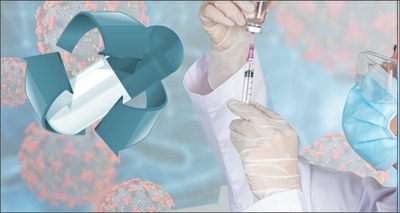Health: On Frontiers a Covid study by ENEA, Universities of Urbino and Singapore
10/12/2020
 An ENEA study conducted jointly with the Universities of Urbino and Singapore has shown new therapeutic values in some drugs -already used in clinical practice- which counteract cellular and molecular mechanisms of SARS-CoV-2 infection and the progression of the disease.
An ENEA study conducted jointly with the Universities of Urbino and Singapore has shown new therapeutic values in some drugs -already used in clinical practice- which counteract cellular and molecular mechanisms of SARS-CoV-2 infection and the progression of the disease.
The study, which used Big Data analytics tools, i.e. computing platforms which handle very large data sets, was published on the platform "Research Square" and is soon to appear in the international peer-reviewed journal "Frontiers in Pharmacology" as well.
The study was conducted with a repurposing approach, i.e. adaptive reuse - among the European Community recommandations – and deals with existing drugs, approved by both the European Medicines Agency (EMA) and the Food and Drug Adminstration (FDA), known for their action as antitumor, chemopreventive, bronchodilator, antihypertensive, but capable of interacting with the molecular targets of COVID-19, blocking or limiting its progression. The in silico study made it possible to predict the molecular mechanisms of infection and uncover possible drugs.
"Seeram Ramakrishna, one of the three most highly regarded researchers in the world in the field of bioengineering, according to the recent Google" World ranking of scientists”, valuably contributed to the study ", Laura Teodori, at the ENEA Diagnostics and Metrology Laboratory, first author of the publication, explained .
"The study was the first ever to identify the protein HDAC (histone deacetylase), one of the most important molecules that regulates gene expression, as a useful therapeutic target to fight the virus.
The results, validated by comparison with the clinical data of a Chinese study on 1096 COVID-19 patients [1], open the way to new studies in the field of drugrepurposing and drug-discovery ”, Teodori said.
"Subsequently, other groups have indicated HDAC as a useful target for fighting the SARS-CoV-2 virus. It is a significant outcome from a clinical point of view, as there are already a number of drugs and bioactive compounds of natural origin like quercetin, a flavonoid contained in some foods, with proven HDAC inhibitory activity, currently used for other diseases, that could be redeployed to combat COVID-19”, Teodori concluded.
For more information please contact:
Laura Teodori, ENEA - Diagnostics and Metrology Laboratory: laura.teodori@enea.it
National University of Singapore: seeram@nus.edu.sg
Università di Urbino, Scuola Di Farmacia: maria.albertini@uniurb.it; piero.sestili@uniurb.it
Articles:
- https://www.frontiersin.org/articles/10.3389/fphar.2020.582003/abstract
- https://www.researchsquare.com/article/rs-29446/v1
World Ranking of Scientists:
https://drive.google.com/file/d/1bUJrvurVVBbxSl9eFZRSHFif7tt30-5U/view
[1] Guan, W. et al. (Clinical Characteristics of Coronavirus Disease 2019 in China. N. Engl. J. Med. NEJMoa2002032, 2020).
